Orthodontics – Warsaw, IN
Achieve a Healthy, Beautifully Aligned Smile!
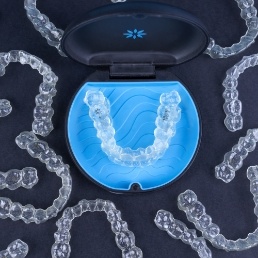
If you’re feeling self-conscious about your crooked teeth, chances are that the last thing you want is to draw attention to them with awkward metal braces. At East Center Dental, we’re proud to offer a more discreet and comfortable orthodontic solution: Invisalign clear aligners. With this solution, adults and teenagers alike can achieve a healthy, beautifully aligned grin without cumbersome metal brackets and wires. We use state-of-the-art 3D computer scanning provided by iTero® to show a simulation of how amazing your smile will be! Contact our dental office today to set up your consultation and find out if treatment with Invisalign orthodontics from our Warsaw, IN dental office is right for you.
Why Choose East Center Dental for Orthodontics?
- Dentist with 100s of Simple to Complex Cases
- Preview Your Results with Virtual Smile Design
- Cozy Blankets, Neck Pillows, & Other Amenities Offered
Invisalign® Clear Aligners
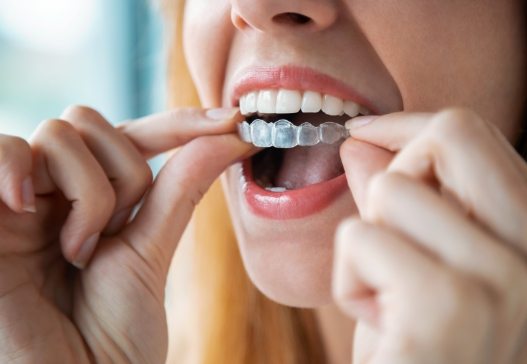
Invisalign is a more convenient and image-friendly alternative to traditional braces. It subtly repositions your teeth using transparent aligners. You’ll wear a series of these aligners throughout the course of your treatment, with each set being worn for about two weeks before switching to the next. Each pair of aligners represent one step closer to having a flawlessly straight smile.
Who Can Invisalign Help?
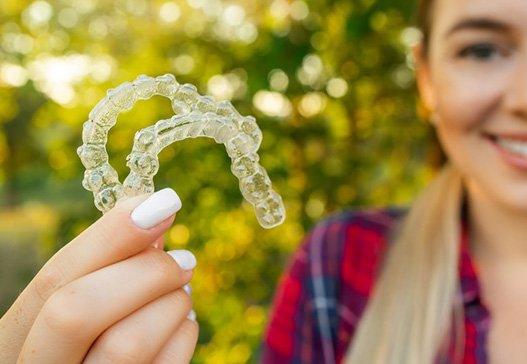
Since Invisalign was approved by the FDA in 1998, it has exploded in popularity to become one of the most sought-after orthodontic treatments available. The process can address a range of mild to moderate alignment issues so patients can enjoy healthier and more beautiful smiles. Here’s a brief guide to some of the alignment problems Invisalign can treat from the team at East Center Dental, but please contact our staff if you would like more information.
Crowded Teeth
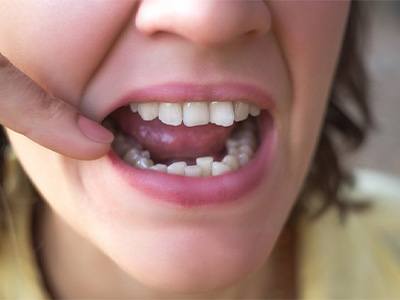
Teeth that are too close together are harder to clean and easier to injure, and crowding often becomes worse with age as the teeth shift over time. This problem can make a person more vulnerable to tooth decay, gum disease, jaw pain, and eating difficulties. Luckily, Invisalign can gradually shift the teeth so they sit evenly next to one another, creating a more efficient bite and making brushing and flossing much easier. This can also bolster a person’s confidence by making their smile more visually pleasing.
Gaps Between Teeth
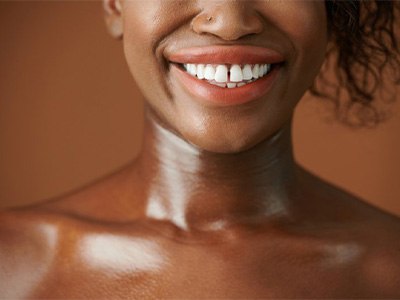
Gaps between teeth can happen because the jaw is especially large, the teeth are unusually small, prolonged thumb sucking in childhood, or a range of other natural factors. By closing these spaces, Invisalign can reduce the risk of bacteria and plaque accumulating between the teeth while protecting the gums from infection and injuries.
Overbite
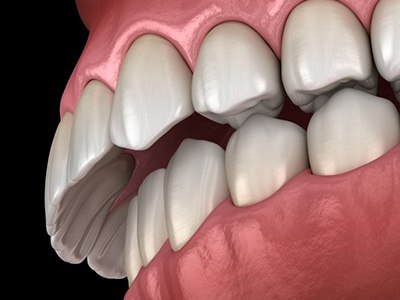
Overbites involve the top teeth sitting too far in front of the bottom teeth, leading to issues such as jaw discomfort, speech problems, uneven tooth wear, and problems with opening or closing the mouth. This problem can also make the top teeth more prone to injury due to them sticking out too far.
Underbite
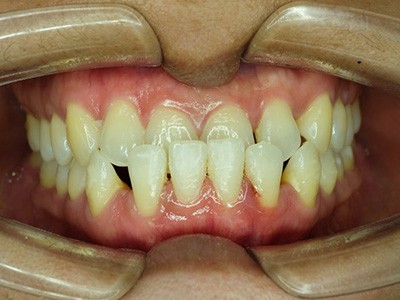
An underbite is when the bottom teeth match or go slightly past the top teeth when the mouth is closed, and it can result from genetic factors, oral trauma, or sucking one’s thumb for too long as a child. An unaddressed underbite can lead to issues such as a greater risk of sleep apnea, mouth breathing, and problems with eating and speaking. While it’s usually easier to treat underbites in younger patients, it’s still important to address them in adults. To treat underbites, Invisalign typically requires the use of appliances like rubber bands to help adjust the bite.
Crossbite
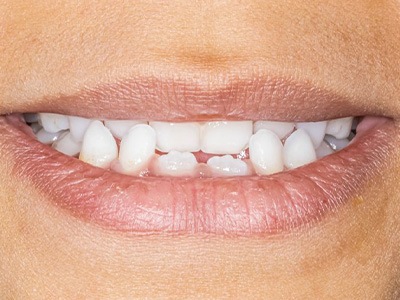
A crossbite happens when the bottom teeth sit slightly in front of the upper arch, and it is usually caused by factors like genetics, poor oral habits, or the early loss of baby teeth. While Invisalign can fix this issue, doing so may require the use of elastics or other accessories if the problem arises from the way the jaw developed. An unaddressed crossbite can lead to long-term problems such as a greater risk of tooth decay and gum disease, jaw pain, speech problems, headaches, teeth grinding, facial asymmetry, and a lack of confidence.
Open Bite
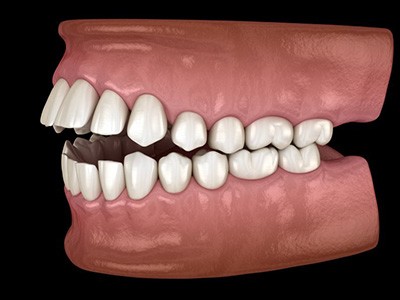
An open bite describes when the top and bottom teeth do not touch or overlap when the mouth is closed, and it usually results from suboptimal bone development or prolonged sucking of the thumb or pacifiers in childhood. This problem can make it difficult to pronounce certain sounds and words as well as excessive enamel erosion on the back teeth. Invisalign can address this issue by bringing the top and bottom teeth together to reduce the risk of dental damage.
Benefits of Invisalign

Did you know that Invisalign has helped more than 12 million patients straighten their teeth over the last two decades? Now you might be wondering, “Why have so many teens and adults chosen Invisalign over metal braces?” Here are a few reasons:
Improved Comfort

Traditional braces aren’t just noticeable; they are uncomfortable at times. The good news is that Invisalign doesn’t have any metal brackets or wires that will irritate your gums, lips, and tongue. Instead, the trays are crafted from smooth plastic and custom-made to fit the unique contours of your mouth.
Tip: If one of your trays has a sharp edge, use a piece of dental wax to cover it, preventing soft tissue irritation in the process.
See-Through Aligners
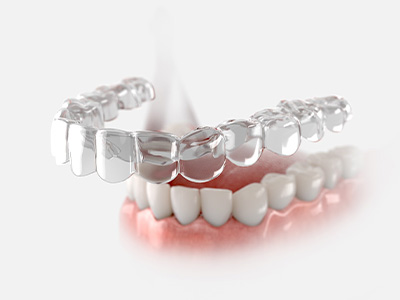
Hands down, one of the top benefits of Invisalign is that it’s completely metal-free. In fact, the trays are so clear that even those closest to you will have a hard time telling when you are and aren’t wearing them. The key is taking good care of them so they don’t develop stains. Don’t worry – that’s easy too!
Easy Dental Hygiene
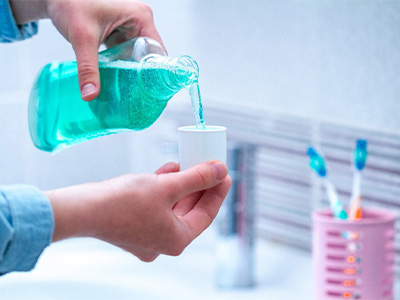
With other orthodontic treatments, you need to brush and floss around the brackets and wires. This not only requires special oral hygiene products, like interproximal toothbrushes, but it also requires more time and effort. Fortunately, the same cannot be said with Invisalign. All you need to do is take off your aligners, rinse them thoroughly, and store them somewhere safe before brushing and flossing like usual.
Fewer Follow-Ups

At the beginning of your treatment, we will provide you with several aligners. That way, you don’t need to come into our office every week or two to get the next set in the series. When you do come in for your follow-up visits (which are usually every 6-8 weeks), we will take updated scans of your teeth and, if everything looks good, send you on your way with the next few sets of aligners. Usually, the entire process only takes 15 minutes!
No Dietary Restrictions

Popcorn, whole apples, celery, raw nuts, and tortilla chips are a few foods that you need to completely remove from your diet with traditional braces. Once again, that’s not the case with Invisalign. Since the aligners are removable, you’ll be free to enjoy all of your favorite foods and drinks throughout your teeth-straightening journey. All we ask is that you do your best to keep sugary and starchy products to a minimum to ensure your teeth and gums stay healthy.
Living with Invisalign Aligners

Compared to other orthodontic treatments, Invisalign is hassle-free. After all, you don’t have to worry about adjusting your diet, buying special oral hygiene products, or coming in for adjustment appointments every couple of weeks. With all of that said, it’s still a commitment, and you do need to abide by certain guidelines in order to stay on-track with your treatment plan. So, we’ve dedicated this next section to a few things you need to know about life with Invisalign.
Wearing Your Trays
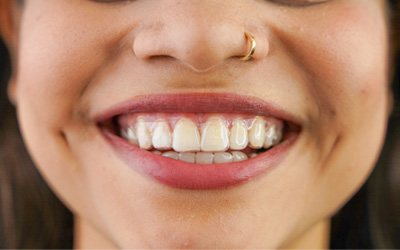
Although your trays can be removed at any time, you should get in the habit of only taking them out when absolutely necessary. If you take them out more than that, there’s a higher chance of your teeth not tracking properly, causing you to fall off-track with your treatment plan. In short, you should make a conscious effort to wear your aligners for 20-22 hours a day throughout your entire teeth-straightening journey.
Cleaning Your Aligners
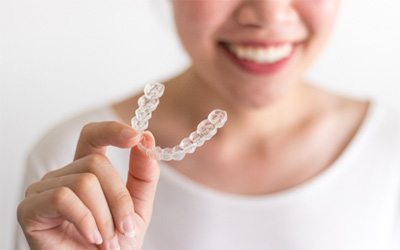
It’s common for patients to assume that they need a bunch of things to keep their aligners clean – from toothpaste and mouthwash to denture cleaner. In reality, you only need two things: clean, cool water and a soft-bristled toothbrush. If you find that your trays are beginning to discolor, then use the cleaning crystals that came in your welcome kit. Under no circumstances should you use a household cleaner, like bleach, instead.
Eating & Drinking

Unlike traditional braces, Invisalign doesn’t require you to cut out whole apples, raw celery, and other crunchy foods from your diet. With that said, it’s still important to be mindful of what you eat, especially when it comes to sugary items that can cause cavities. That’s why we encourage our patients to fill their plates with lots of nutrient-dense foods, like cooked vegetables, lean protein, and fresh fruit – it will help keep your teeth and gums decay and infection-free!
Losing or Damaging a Tray

You may panic when you realize that you’ve lost one of your trays or that there is a crack in one of your aligners. However, handling this orthodontic emergency correctly really comes down to one step: calling our Warsaw dental team. From there, we can determine what the next best step is depending on where you are in your treatment plan. For some, that’s having a replacement tray made. For others, it’s moving onto the next aligner a bit early.
Routine Check-Ins
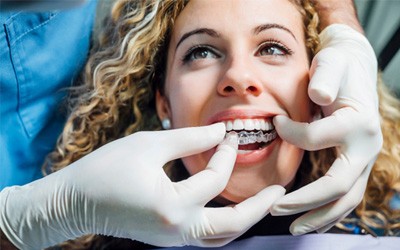
The check-in visits at our office are significantly less with Invisalign. Of course, that doesn’t mean that they aren’t important. These appointments allow us to monitor the movement of your teeth, ensure everything is tracking as expected, and make changes to your treatment plan if there is a problem. Usually, these visits are only 15 minutes are so, so they easily fit into even the busiest schedules.
Understanding the Cost of Invisalign

If you don’t want to endure a mouthful of metal brackets and wires to get the beautiful, straight smile you’ve been looking for, Invisalign could be the solution! When attempting to understand how much your treatment will cost, the truth is that it’s impossible to know before you attend a consultation with us. During this visit, Dr. Rudolph will examine your smile, formulate a treatment plan, and provide you with a clear estimate as to how much the cost of Invisalign will be. Until then, here are some things to keep in mind.
Factors that Affect the Cost of Invisalign
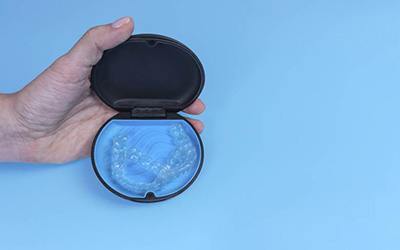
The cost of your treatment will depend on several different factors. Here are some of the most prominent:
- Number of Arches: Most people who undergo Invisalign will have both their upper and lower jaw addressed. However, in some cases, only one arch needs to be corrected. In this situation, the cost is lower.
- Complexity of Treatment: If you have severe alignment issues, your treatment is likely to cost more. Closing a few small gaps is cheaper than correcting a significant bite problem.
- Treatment Length: A longer treatment time ultimately means additional aligners and a higher treatment cost.
Invisalign VS Smile Direct Club™: Which Costs More?

For patients who are looking for a “quick fix,” lower budget options, like Smile Direct Club™, may seem tempting, but a lower cost doesn’t necessarily mean that it’s the best choice for you. While the price is generally lower than Invisalign, Smile Direct Club™ has a do-it-yourself approach with little to no oversight from a dental professional. This means additional room for error, and you could end up with serious issues that will need to be treated by a professional anyway.
When you opt for Invisalign, you have the trusted oversight of Dr. Rudolph for every step along the way. Invisalign is professionally made, uses highly accurate impressions, and results in a more successful treatment overall. The difference in cost is worth it for a smooth, stress-free orthodontic treatment.
Does Dental Insurance Cover Invisalign?
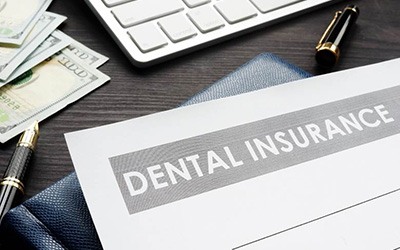
Only some dental insurance plans include coverage for orthodontic treatment, so you should check with your insurance provider to see if this is the case for you. We’re happy to accept many different dental PPOs, and we can give you a brief outline of what kind of coverage you can expect if you call us with your dental plan information.
Options for Making Invisalign Affordable

If you don’t have dental insurance, this doesn’t mean that you’re completely out of luck. We work with CareCredit – a third-party financing company that can split the cost of your treatment into manageable monthly installments with little to no interest. Talk to one of our friendly team members to learn more about your financial options.
To find out exactly how much you can expect your Invisalign treatment to cost, give us a call to schedule a consultation. We’re eager to help you achieve a straighter smile!
Invisalign FAQs
How Long Does Invisalign Take?
It depends. On average, it takes 12-18 months to finish treatment. However, every patient has unique smile circumstances, and several factors affect the amount of time it takes to achieve your desired results, such as the severity of your misalignment and your commitment to the treatment plan. People with mild orthodontic issues can expect to finish up in as soon as six months! If you have a more severe case of dental misalignment, you can expedite the process by visiting your cosmetic dentist in Warsaw regularly and diligently following treatment instructions.
Can You Eat with Invisalign?
The best part about Invisalign is that there are no dietary restrictions while you undergo treatment. Since the clear aligners are removable, all you must do is take them out before you eat. Otherwise, you risk damaging the aligners, causing cracks and stains. It also places unnecessary pressure on your teeth. That said, you should always take out your plastic trays and store them in a safe place before eating or drinking anything that’s not water.
What Happens After Invisalign?
Once you’ve completed the last aligners in the series, you’ll visit your dentist to verify the results. They will ensure your teeth are in the desired, straight position before briefing you on what maintenance for your newly aligned smile will look like. Post-treatment will begin with wearing a retainer. These are designed to be much more comfortable to wear than those in the past, and you’ll usually get to choose between wire retainers and clear plastic ones that look similar to Invisalign. Based on your specific needs, your dentist will recommend how often you’ll need to wear your retainer. Usually, you’ll start wearing it full time before gradually decreasing to only wearing it at night.
What Does Invisalign Look Like?
Designed with transparent plastic, Invisalign clear aligners are visible when outside of the mouth, but incredibly hard to detect once worn. With proper maintenance, patients can keep their aligners clean, clear, and discreet. Unlike traditional braces that require brackets and wires, Invisalign’s predictable clear aligners allow patients to achieve straight teeth without compromising their appearance. In some cases, patients may require attachments, buttons, or elastics that help during the alignment process. These items are not made of clear plastic and sometimes are more visible than the rest of the aligners.
How Do I Clean My Invisalign?
Luckily, cleaning your Invisalign aligners properly doesn’t require anything too complex. In fact, the majority of the time all you’ll need is a soft-bristled toothbrush and lukewarm water. After rinsing your trays, use your toothbrush to gently scrub each surface of your aligners. Then, rinse them off again and put them back in your mouth. That’s it!
Note: if your trays are starting to stain, then make sure you are taking good care of your teeth and not drinking anything other than water with your aligners in. You can also use your Invisalign cleaning crystals to give them a deeper clean if they look more yellow than clear.
Does Invisalign Hurt?
To be honest, any orthodontic treatment will come with some soreness as your teeth are being moved into their properly aligned positions. With that said, Invisalign is considered one of the most comfortable options since the trays are custom-made for each patient and crafted from smooth plastic. In other words, there aren’t any metal brackets or wires, so you won’t have to worry about soft tissue irritation, cuts, and the like!
Who is Not Eligible for Invisalign?
There are some people who aren’t candidates for Invisalign, including young children. Additionally, clear aligner treatment may not be the best option for you if you have trouble keeping track of your belongings. After all, consistently losing your trays can quickly cause you to fall off-track with your treatment plan, requiring a bigger investment of your time and money.
It’s also important to mention that if we find tooth decay, gum disease, or another serious dental problem present during your initial consultation, then we will need to address it before ordering your clear aligners. The good news is that we offer a number of restorative dental services at our Warsaw dental office, so it’s easy to incorporate the appropriate one into your treatment plan.
What if My Invisalign Broke?
If one or both of your aligners broke, don’t try to repair them with super glue. This may seem like an easy fix, but there are toxins in household adhesives like these that are not safe to ingest. Therefore, your top priority instead should be calling us. Over the phone, you can explain more about your situation (including how severe the break is) so our knowledgeable team can determine what the best course of action is.
What Are Invisalign Attachments?
For patients with more moderate cases of malocclusion, their treatment plan may include attachments as well as aligners. In short, these are small pieces of tooth-colored resin that are bonded directly to the front-facing surfaces of your teeth. This creates discreet bumps that your trays can grip, creating more movement. While some patients have just one or two, others have upwards of 20 or more – it depends entirely on your unique dental needs.
Note: placing the attachments on your teeth and removing them doesn’t hurt or damage your enamel in any way either!
I Need a Checkup & Cleaning I Need a Dentist for My Child I am Concerned About Bleeding Gums I Have a Cavity or Broken Tooth I am Missing One or More Teeth I Want to Enhance My Smile I am Scared of the Dentist I am in Pain & Need Help I am Concerned About Sleep Apnea View Our Services
